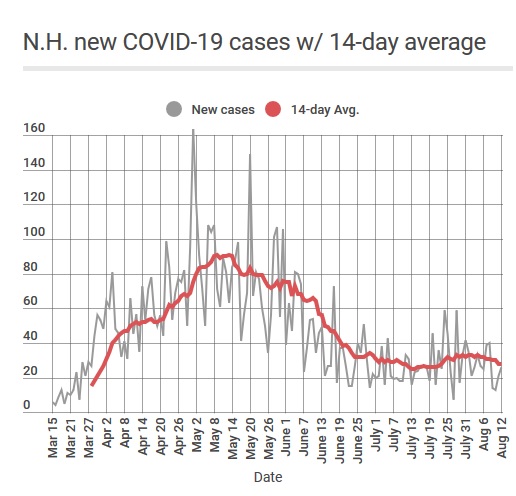When it comes to driving safely there are two important factors to consider: How fast you’re going and how fast you’re accelerating.
If you’re driving 10 mph you’re probably safe – unless you’ve just stomped on the gas and are peeling out with smoking tires, in which case you might wreck anyway. And if you’re traveling at a steady speed you’re probably safe – unless you’re going 110 mph on a winding road.
It’s the same with COVID-19 caseloads. The total number of new daily cases in the state is the pandemic’s speed, so to speak, and how fast the number is changing is the acceleration. Both matter.
Happily for us the pandemic’s “speed” has been low since June and the “acceleration” negative, meaning the caseload was getting smaller, which is why the Monitor’s weekly COVID tracker was optimistic in late July.
But recently the acceleration swung back into the positive as the two-week average number of new cases crept up from mid-20s to mid-30s. Even though that new-case figure remained below our threshold of concern – our “speed” is still low – the fact that it was growing caused the tracker to backtrack for the first time on our judgment of the pandemic’s status.
Over the past week, that acceleration has ended but the number of daily new cases remains higher than it was a month ago. So the increase in new cases wasn’t a blip that goes up and down, it’s proving to be a mesa that goes up and stays there.
With the opening of many schools and colleges just a few weeks away, that’s worrisome.
Here’s the latest tally:
Goal 1: A two-week drop in cases as measured by the 14-day running average, which would indicate that the virus is not spreading.
Have we met this goal? No.
As noted above, the two-week average of new cases has been stagnant at around 34 since the start of the month. It is not dropping.
Goal 2: Fewer than four new cases per 100,000 people each day, or 54 new cases a day, which would show that the disease is below dangerous levels.
Have we met this goal? Yes, easily.
Goal 3: Conducting at least 150 PCR tests, which spot current COVID-19 cases per 100,000 people each day. New Hampshire has 1.35 million people, so that works out to 2,000 tests per day.
Have we met this goal? Yes.
More than 2,000 test results were reported most days recently and the average is 2,144 per day. The number of people tested is much less because of multiple tests to individuals working in health care.
Goal 4: A positive rate of PCR tests below 5%, indicating that the virus is not spreading rapidly in the general population.
Have we met this goal? Yes.
The positive rate has been around 3% as measured by the Department of Health and Human Services for more than two months.
I update three charts each weekday on the virus in New Hampshire: New cases, new hospitalizations and total deaths.


 Return to the Concord Monitor
Return to the Concord Monitor
For what it’s worth, the NYT now has us as a “new cases decreasing” state. (At least as I type. It’s pretty volatile.) https://www.nytimes.com/interactive/2020/us/coronavirus-us-cases.html
“At least 21 new cases were reported in New Hampshire on Aug. 11. Over the past week, there have been an average of 24 cases per day, a decrease of 29 percent from the average two weeks earlier.”